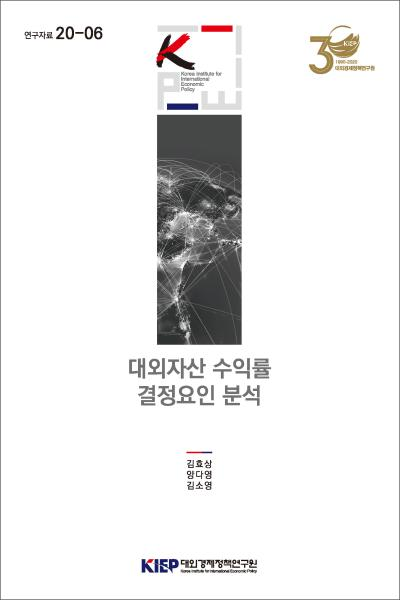전체보고서
발간물
전체보고서
목록으로

금융 세계화 또는 글로벌 금융통합의 진전으로 선진국과 신흥국 모두 대외자산 및 대외부채가 크게 늘어남에 따라 각국은 환율과 자산가치 변동으로 야기되는 자본손익에 노출되게 되었다. 본 연구는 개별 국가를 경제의 대표 주체로 보고 국가 차원의 대외자산 및 대외부채의 구성에 따른 수익률을 구축하는 한편 이에 대한 결정요인을 분석하였다. 이를 위해 먼저 내국인의 해외자산 수익률, 외국인의 국내자산 수익률, 순수익률 등 각국의 대외자산 수익률을 정의하고 Lane and Milesi-Ferretti(2018)와 IMF의 Balance of Payments(BOP) 데이터를 사용하여 산출하였다. 각국의 대외포지션이 최적(optimal)의 투자 포트폴리오라고 가정하면, 본 연구에서 정의한 순수익률은 각국의 위험 프리미엄을 직접적으로 나타내며, 자산 가격결정 이론 측면에서는 내국인의 해외투자에 롱포지션, 외국인의 국내투자에 숏포지션을 동일한 규모로 취한 포트폴리오의 초과수익률(excess return)과 의미가 같다.
본 연구는 이렇게 산출한 각국의 대외자산 수익률을 바탕으로 정성적 분석 및 실증분석을 실시하여 경제적 함의를 찾고자 했다. 먼저 1980년을 기준으로 각국의 누적 순수익률 추이를 보면 선진국이 신흥국보다 훨씬 컸는데, 이는 신흥국의 경우 내국인 해외자산 수익률이 외국인 국내자산 수익률보다 낮았기 때문이었다. 그래프를 이용한 정성적 분석에서 평상시에는 선진국이 신흥국보다 대외자산 수익률이 높고 해외투자 시 더 효율적이며 해외투자를 통한 위험 공유 및 소비 평활화 경로가 잘 작동되고 있음을 알 수 있었다. 반면 신흥국은 해외투자를 통해 금융위기 등에 대응함으로써 위기 시 수익률이 평상시보다 높았다.
대외자산 수익률 결정요인에 대한 실증분석 결과, 순수익률은 자산규모가 클수록, 위험자산 비율이 클수록 높았으며, 자국 통화가치 상승, GDP 성장률, 물가 상승률, 경상수지와는 음(-)의 관계로 나타났다. 금융발전도, 금융개방도, 자본통제 정도, 거시건전성 시행 여부 등 정책요인을 고려하는 경우 또한 순수익률은 금융시장 및 기관이 발전할수록, 금융시장 개방도가 높을수록 높게 나타났다. 국제금융시장의 불안을 나타내는 VXO와의 교차항을 고려한 분석에서 평상시에는 금융발전도와 내국인 해외자산 수익률 간 관계가 양(+)의 관계로 나타나지만 금융 불안 시 그러한 효과가 상쇄됨을 확인했다. 또한 외환보유액이 일반적인 예상과 달리 내국인의 해외자산 수익률이 아닌 외국인 국내자산 수익률과 관계가 있는 것으로 나타났는데, 외환보유액 규모가 클수록 외국인의 국내자산 수익률이 높아졌다. 이는 외환보유액 규모가 큰 국가일수록 무역흑자, 높은 경제성장률, 높은 총요소생산성 증가율 등 경제여건이 양호할 가능성이 높아 평상시에는 외국인 투자자에게 높은 수익률을 가져다주기 때문인 것으로 보인다. 그러나 금융 불안이 있을 경우에는 그러한 효과가 감소하는 것으로 나타났다.
As external asset positions increased significantly in both developed and emerging countries due to globalization and financial integration, countries are exposed to capital gains and losses caused by fluctuations in exchange rates and asset values. This study constructs the return rate of external asset position (rate of external) by considering the individual country as the economy’s representative agent. Assuming that the foreign asset position is the optimal investment portfolio, the rate of external defined in this study directly measures the country’s risk premium. The rate of external is also the excess return of the portfolio that takes a long for foreign assets and a short for foreign liabilities.
We observe that advanced economies have a far greater rate of external than emerging countries in general. In comparison, emerging countries have a relatively higher rate of external during crisis periods. Thus, international risk sharing and consumption smoothing mechanism works through external investment. Advanced economies are in a speculator position, while emerging countries are in a hedging position.
We also empirically analyze the determinants of the rate of external. The rate of external is higher as the foreign assets’ size, and the proportion of risky assets increased. There are negative relationships with the domestic currency value, GDP growth rate, inflation rate, and current accounts. The rate of external is higher as the financial market and institutions developed, and the financial market openness increased. However, these effects are offset in the event of financial instability proxied by the VXO index.
Contrary to general expectations, foreign reserves are likely to relate to the return on foreign liabilities rather than foreign assets. The more the foreign reserves, the higher the return on foreign liability. Countries with larger amounts of foreign reserves are more likely to have favorable economic conditions such as trade surplus, higher growth rate, and higher productivity, bringing a higher return rate to foreign investors. These effects, however, disappear in times of financial instability.
국문요약
제1장 서론
1. 연구의 배경과 목적
2. 선행연구 현황과 연구의 차별성
3. 한국의 대외자산 및 대외부채 추이
제2장 대외자산 수익률 산출과 추이 분석
1. 대외자산 수익률 산출
2. 대외자산 수익률 추이
3. 정성적 분석
제3장 대외자산 수익률 결정요인 분석
1. 분석 방법
2. 분석 결과
제4장 결론 및 시사점
참고문헌
부록
Executive Summary
판매정보
| 분량/크기 | 90 |
|---|---|
| 판매가격 | 5000 원 |
 공공저작물 자유이용허락 표시기준 (공공누리, KOGL) 제4유형
공공저작물 자유이용허락 표시기준 (공공누리, KOGL) 제4유형
대외경제정책연구원의 본 공공저작물은 "공공누리 제4유형 : 출처표시 + 상업적 금지 + 변경금지” 조건에 따라 이용할 수 있습니다. 저작권정책 참조
콘텐츠 만족도 조사
이 페이지에서 제공하는 정보에 대하여 만족하십니까?
